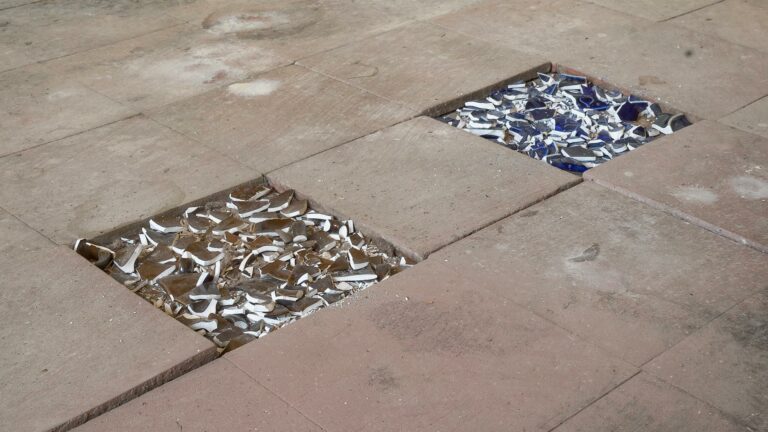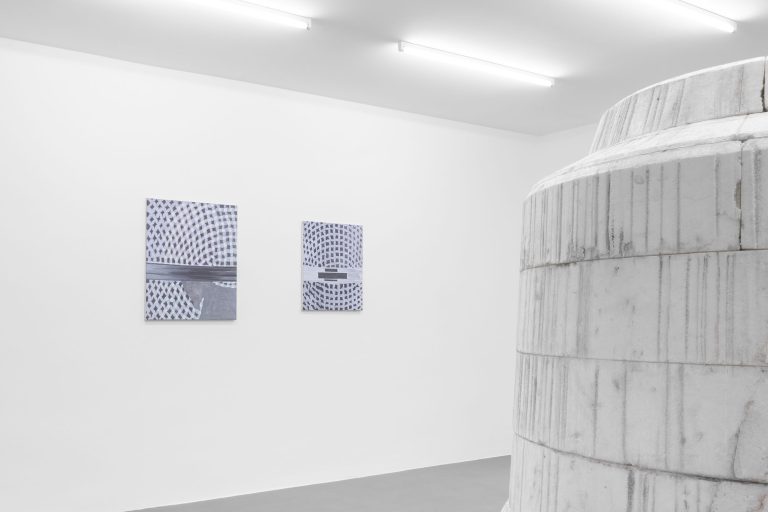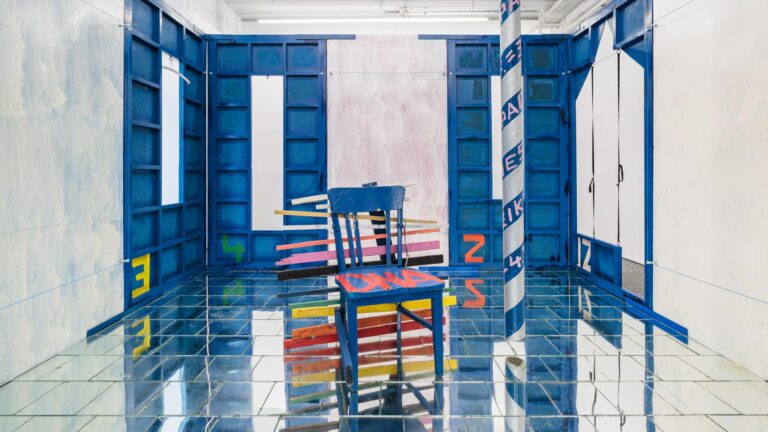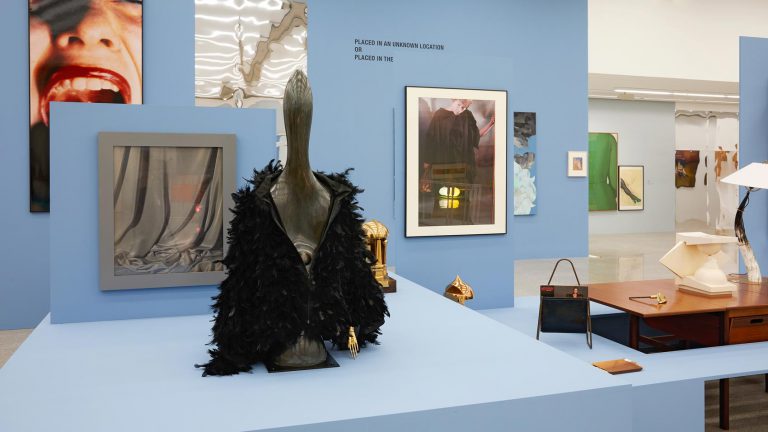Artist: Heinz Frank
Exhibition title: The Angle of the End Always Comes from Behind
Curated by: Lucas Gehrmann
Venue: Kunsthalle Wien, Vienna, Austria
Date: February 2 – May 12, 2019
Photography: all images copyright and courtesy of the artist and Kunsthalle Wien
Note: Exhibition booklet can be found here
“My practice resides in the in -between space between the void inside and the inner outside”: so says Heinz Frank, who, after studying architecture with Ernst A. Plischke in the 1960s, has worked as a sculptor, draftsman, painter, creator of linguistic and object art, and, occasionally, designer of interiors and furniture. Accomplished in mobilizing multiple media, he interlaces, freely mixes and matches various materials such as: wood, stone, plaster, paint, clay, glass, metal, and found fabrics, wires, boxes, trestles, mirrors, or parts of old household appliances. Combining, assembling, and transforming these and other objects and devices, Frank probes the tensions between polar opposites such as hard and soft, hot and cold, inside and outside, heavy and light, beginning and end, pinpointing in forever novel creations how—as well as proposing that—these terms are all interconnected. To use a paradoxical formula in which the artist once summed up his objective: “Transforming the unformed into the formless.”
It is always the word that lies at the beginning of his creative process—or, more specifically, an aphoristic conceit, noted by hand on a piece of paper, that now accompanies the work whose genesis it sparked. “The hole is the epitome of emptiness,” “Of the long- nosed monkey me,” or “The posterior and the anterior of the others” … we read juxtaposed beside individual pictures and sculptures. Another anthropomorphic sculpture, for its part, has: “No back of the head, for the vertex toward the funnel was born to think.”
Frank’s polymorphous amalgamations of linguistic and visual art (the exhibition gathers works dating from different periods since 1963) transport the beholder into a world of ideas in which human existence, the origin and trajectory of thoughts, the body, and the inner life are central themes. What the cogwheels of everyday life, where rationalism and economic considerations reign supreme, keep neatly separate is here undivided: reason and emotion. Heinz Frank puts forwards that both are interdependent and therefore equipollent: what makes the human being human is the thought that is felt and vice versa. Hence one of his mottos: “Thinking what one feels and feeling what one thinks.” The artist makes use of the glass curtain walls at the Kunsthalle Wien Karlsplatz exhibition hall to hang double-sided painted pictures on the insides of the panes. Unframed glass is neither window nor hole, but pictures mounted on glass walls can become windows, especially when they have holes. For Frank, eyeholes, usually, through which one can in this instance catch glimpses not only of the emptiness inside a head but of the exterior or interior space behind them. To put it, again, in Frank’s words: “Wall- internal embodies wall-external.” Or: “Humans are the blurred windows on the outside.”
The spatial features of the exhibition space, are also brought into play, particularly the rectangular corners, where four sculptures are located on rugs. A series of painted folding-screens, by contrast, are positioned along the glass panes, standing as tall as Heinz Frank—they are angled movable walls, though they may not shield anything but themselves. the screens also each sport at least one hole, that “epitome of emptiness,” although, one should note, according to Frank: “The hole, [is] thinking’s sixth finger.”
The exhibition at Kunsthalle Wien Karlsplatz reveals Heinz Frank as not only a deft performer of poetically nested conceits and sallies, but also as an architect—who is at home at the drafting table: the measure of his things, of their proportions and relations to the space around them, is always the human being—and, therefore, the artist himself as an embodied I.
Installation view, Heinz Frank. The Angle of the End Always Comes from Behind, 2019, Kunsthalle Wien, Photo: Jorit Aust
Installation view, Heinz Frank. The Angle of the End Always Comes from Behind, 2019, Kunsthalle Wien, Photo: Jorit Aust
Installation view, Heinz Frank. The Angle of the End Always Comes from Behind, 2019, Kunsthalle Wien, Photo: Jorit Aust: Heinz Frank, PORTRAIT EINES SELBSTPORTRAITS MIT LEEREM SCHATTEN (Portrait of a Self-Portrait With Empty Shadow), 1980; HIRNSCHATTEN / SCHATTEN DES LICHTS, SCHATTEN EINES BILDES, (Brain-Shadow / Shadow of the Light, Shadow of the Picture), 1980, Courtesy the artist
Installation view, Heinz Frank. The Angle of the End Always Comes from Behind, 2019, Kunsthalle Wien, Photo: Jorit Aust: Heinz Frank, PERSPEKTIVISCHES EINWÄRTS. MEIN KOPF, EINE RAUMLOSE RÄUMLICHKEIT (Perspectival Inward. My Head, a Spaceless Spatiality), 1980; FENSTER NACH HAUSE (Window Home), 1979, Courtesy the artist
Installation view, Heinz Frank. The Angle of the End Always Comes from Behind, 2019, Kunsthalle Wien, Photo: Jorit Aust
Installation view, Heinz Frank. The Angle of the End Always Comes from Behind, 2019, Kunsthalle Wien, Photo: Jorit Aust
Installation view, Heinz Frank. The Angle of the End Always Comes from Behind, 2019, Kunsthalle Wien, Photo: Jorit Aust: Heinz Frank, DER SEELE MEINER SEELE KLEID… (To the Soul My Soul’s Attire…), 1982, Courtesy the artist
Installation view, Heinz Frank. The Angle of the End Always Comes from Behind, 2019, Kunsthalle Wien, Photo: Jorit Aust
Installation view, Heinz Frank. The Angle of the End Always Comes from Behind, 2019, Kunsthalle Wien, Photo: Jorit Aust















